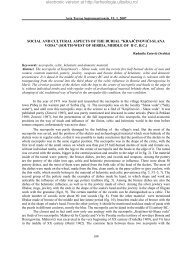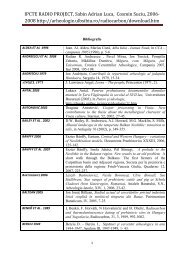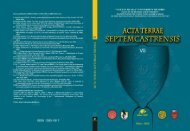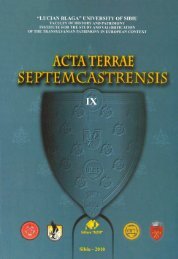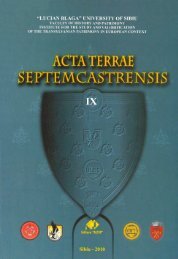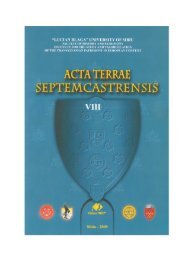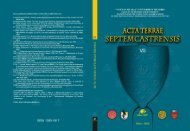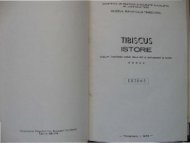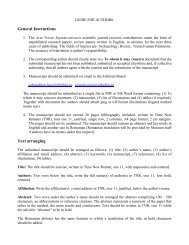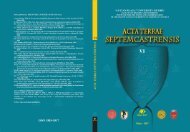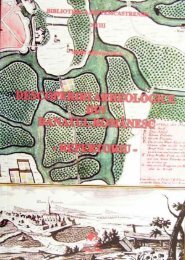acta terrae septemcastrensis viii - Institutul pentru cercetarea Åi ...
acta terrae septemcastrensis viii - Institutul pentru cercetarea Åi ...
acta terrae septemcastrensis viii - Institutul pentru cercetarea Åi ...
Create successful ePaper yourself
Turn your PDF publications into a flip-book with our unique Google optimized e-Paper software.
Acta Terrae Septemcastrensis, VIII, 2009<br />
Germany, Slovenia, Slovakia, Bosnia and Herzegovina, Republic of Moldova,<br />
Croatia, Montenegro and Austria. This macro-region forms a relatively bounded<br />
and cohesive unit―although the geographic layout consists of several small and<br />
discrete micro-regions exploiting a distinct set of local resources that encouraged<br />
regional differentiation among the early farming societies (as well as among the<br />
lexicon and interpretations of the archaeologists).<br />
The “Danube script” is an operational term that does not designate a unity of<br />
literacy that lacks documentary evidence. When DatDas reaches the needed<br />
critical mass of information, further investigation is required to assess the unitary<br />
frame called “Danube script” dealing with the distinct paths taken in the<br />
development of writing in the regional Neolithic and Copper Age traditions of<br />
Southeastern Europe. For example, both Hooker and Owens refer to the occurrence<br />
of “Balkan scripts” (Hooker 1992; Owens 1999: 116). Comparing the signs from<br />
the Gradešnitsa culture with those from the coeval cultures of Thrace or<br />
northwestern (former) Yugoslavia, Bogdan Nikolov expressed the conviction that<br />
just a few of them were alike. He concluded that every separate ethno-culture<br />
produced its own sign system responding to its tradition (Nikolov 1984: 7).<br />
Nevertheless, the veracity of this statement has to be demonstrated based on the<br />
understanding of the interconnections of sign use in the different cultural regions.<br />
Up until now, regional and cultural subdivisions have been successfully,<br />
although prototypically, tested by the author in the creation of several subdatabanks.<br />
DatTur is established from the signs utilized by the Turdaş group<br />
(Merlini 2008c); DatVinc registers data on writing from the Vinča culture;<br />
DatPCAT records inscribed finds and inscriptions from the Precucuteni–Cucuteni–<br />
Ariuşd–Trypillia cultural complex evidencing a late script related to the Danube<br />
script (Merlini 2007c, 2008d).<br />
However, criticalities are not only from the side of the cultural and<br />
territorial articulation of the script. The concept and trajectory of the Danube<br />
civilization have to be more suitably substantiated and it is vital to respond to<br />
scholars who negate the presence of a civilization in the Southeastern European<br />
Neolithic and Copper Age. It is first necessary to elaborate a clear definition of<br />
what ‘civilization’ means, in archaeological or anthropological terms, as well as to<br />
chose criteria and benchmarking indicators capable of testing the label of<br />
‘civilization’ for the network of the farming communities in European prehistory.<br />
Cycle of life and the territorial spread of the writing system<br />
Although it is quite probable that the Danube script will remain undeciphered, it is<br />
possible to detect some features of its historical framework and semiotic code<br />
thanks to statistical work made practical by the dedicated databank DatDas. This<br />
databank organizes a catalogue of 5,433 actual signs recorded from a corpus of<br />
1,178 inscriptions composed of two-or-more signs and 971 inscribed artifacts<br />
(some finds have more than one inscription) compared, when possible, to the<br />
original. Between 2001 and 2009, the author had the possibility to visit and<br />
examine many Neolithic and Copper Age collections of the Danube Civilization in<br />
the modern-day countries of the Republic of Serbia, Romania, Bulgaria, Greece,<br />
37



